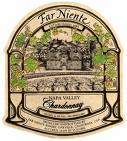This week’s wine reviews (to be posted Wednesday) are chock full of recommendations for modestly priced white wines that will enable you to ride out this Indian summer in style. Seems like further evidence that price is no precursor to pleasure when it comes to wine. Until we get to the Far Niente Chardonnay, which is a budget buster at $56 per bottle.
 So, eyebrows raised, you may ask what it is doing in the mix. Fair question. The answer is quite simple: Sometimes you actually get what you pay for.
So, eyebrows raised, you may ask what it is doing in the mix. Fair question. The answer is quite simple: Sometimes you actually get what you pay for.
Far Niente Chardonnay, more so even than the highly regarded Far Niente Cabernet, is among the finest in its league, for truly exceptional California chardonnays are fewer and farther between than exceptional California Cabernets.
What makes a great Chardonnay is a matter of taste. Some would say the rich, buttery, thick style of chardonnay produced by purveyors such as Rombauer constitute greatness. I would rather wash out my mouth with soap! Not really, but you should understand that generally speaking the oily, buttery chards are not my favorites. The exception would be a Chardonnay such as Talbott’s Sleepy Hollow Vineyard, which has enough acid backbone to balance the fatness of its fruit.
So who makes what I would consider great California Chardonnay? Kistler. Freestone. Patz & Hall, which once was in the Rombauer camp until winemaker James Hall shifted gears a few vintages back. Grgich Hills. Chateau Montelena. Nickel & Nickel. Sonoma Cutrer. There are others. And then there is Far Niente, a Napa Valley icon restored by the late Gil Nickel, a very private person and renaissance man who flamboyantly shunned the limelight.
The common threads in all of the Chardonnays I prize are finesse, balance, flavor intensity, minerality, and what I would call elegant power. These wines are not too heavy; they are not too light. They are all fermented and aged in wooden barrels, yet they don’t reek of oak. They all possess complex flavors and aromas that include fruit, earthy minerality and spice.
And importantly, especially for those of us who know the sheer pleasure of a 10-year-old chardonnay that remains fresh and vibrant, they have the ability to age if cellared properly. Your average run of the mill New World Chardonnay begins to turn a dark color and oxidize a few years after the vintage.
So when I come across one of these gems, I am compelled to share my clearly subjective point of view as well as my enthusiasm for such creations, regardless of price. These wines are invariably made in small quantities and frequently sold only to restaurants and avid collectors. You aren’t likely to find them at the grocery store.
Yet I believe you should know this: If you do find one, and you are tempted to take the plunge, just do it. Occasionally you really do get what you pay for.
8
